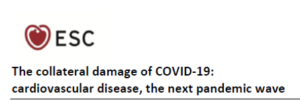 Last June 3rd the European Society of Cardiology published the statement “The collateral damage of COVID-19: cardiovascular disease, the next pandemic wave”, which builds on a survey conducted by the ESC during the pandemic.
Last June 3rd the European Society of Cardiology published the statement “The collateral damage of COVID-19: cardiovascular disease, the next pandemic wave”, which builds on a survey conducted by the ESC during the pandemic.
Evidence and data collected during the pandemic outbreak show that COVID-19 has had a significant impact on patients with cardiovascular disease (CVD). The effects of COVID-19 on cardiovascular health are multifaceted and triggered by different factors including:
- Patient vulnerability and lack of assurance that safe in-hospital wards will be provided to non-COVID patients: CVD patients infected with COVID-19 have increased rates of complications and death. Because of this, high risk CVD patients such as those experiencing a heart attack or stroke have been reluctant to seek help resulting in significant reduction in admission for heart attacks and stroke in Europe and elsewhere and an increase in preventable death and disability
- Increased pressure on ambulance services: this has resulted in late presentation to hospital of heart attacks and stroke patients – often too late to benefit from life-saving treatments
- Re-prioritisation of hospital resources: this has significantly decreased access to cardiovascular services and elective procedures as well has led to a drastic reduction in the availability of cardiac surgery
Based on surveys that the European Society of Cardiology has conducted of its members and of other evidence available so far, the paper outlines how COVID-19 has impacted CVD and provides recommendations for mitigating actions to save lives and reduce suffering.
The repercussions of the pandemic on CVD mortality and morbidity risk being exponential unless bold policy action is taken. Therefore, the European Society of Cardiology calls on health ministers and other decision-makers in charge of the management of healthcare systems to put in place the following measures without hesitation:
- The creation of agile and rapidly responsive Europe-wide health-data collection (through registries or via discharge summaries and electronic health record) which allows a rapid feedback on admission and outcome trends. This is of paramount importance in a health emergency, but also essential for learning from individual countries’ experience and planning and targeting health investment to reduce inequality.
- Ensure that patients can be treated safely in the case of cardiac emergencies through the development of treatment pathways completely separate to those being used for patients with the coronavirus to reduce their exposure to the risk of infections.
- Resume CVD clinical activity as soon as possible and in a safe environment, so that CVD prevention, diagnostic and treatment can take place in a “quasi-normal” environment. It is well reported that delaying visits and procedures lead to more severely damaged hearts and the need for more invasive and severe clinical interventions to try to fix them. As waiting times for several elective procedures are already quite long in different countries without the COVID-19 context, it is crucial to avoid any further delays.
- Robust randomized evidence is needed to support clinicians’ decisions on which treatments should be recommended for COVID-19 patients with pre-established CVD or at high risk of developing CVD.
- Support high-quality prospective studies to better understand the mechanisms through which pre- established CVD worsen the prognosis in COVID-19 and assess whether COVID-19 increases cardiovascular risk and cardiovascular sequelae.
- Support investment in cardiovascular research and innovation so that new, affordable therapies can be developed for conditions where current treatments may temporarily relieve symptoms but do not improve patient outcomes, such as death and disability.

